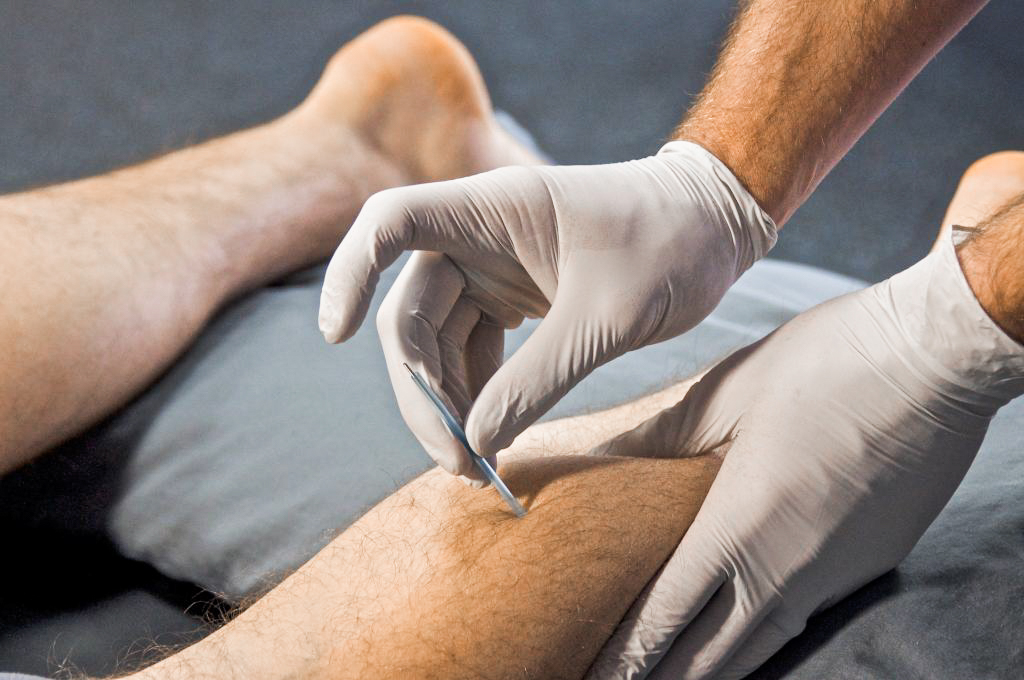
One of the most common questions we as dry needling education providers are asked is what is the difference between dry needling and acupuncture. The discussion surrounding this is often contentious across social media platforms with some who argue that dry needling is exactly the same as acupuncture and others who believe that they are distinctly different practices. We want to take on this argument and provide some of the facts about what dry needling and acupuncture are and what makes them different. Essentially, this is what it comes down to: the tool that both procedures use may be similar, but the theory and application are completely different.
Who are acupuncturists and what do they do?
Acupuncture is a procedure provided by a professional. Often, those who provide acupuncture are called “acupuncturists,” lumping an entire group of professionals together by a single procedure that they provide. But, “acupuncturists” provide a wide repertoire of interventions. We should be considering their entire scope of activities within their practice to define the profession, not just one procedure.[i] Some states have aptly opted to designate these professionals as an Oriental or East Asian Medical Practitioner instead of an Acupuncturist, referring to the myriad of services they provide, including acupuncture.
For our discussion on the differences between dry needling and acupuncture, we are solely discussing the procedure of acupuncture and not the profession. State boards who regulate licensure of health care professionals explicitly define dry needling by a physical therapist and acupuncture by an East Asian Medial Provider as two different procedures. While they may be similar in the tool that is used, the theory and application are different.
Let’s talk about the needle itself.
While a hypodermic needle can be used for dry needling, solid fine filament needles are more common and there are many different applications. When someone on the internet sees a photo of dry needling and mistakes it for acupuncture, that can be an honest mistake, because the tool used for both dry needling and for acupuncture is the same. But this is where the similarities end.
The theories behind dry needling and acupuncture are different on a basic level.
Dry needling by physical therapists is a needling procedure without injectate that has many forms. Some dry needling is practiced based on trigger point philosophy,[ii] others on radiculopathic theory,[iii] and still others on complex neurophysiologic premises. On the other side, traditional acupuncture is based on theories of balance between yin and yang and access points to energy along meridians. Other forms of acupuncture can be based on training in western biomedical sciences.
The different theories lead to differences in training, concepts, thought processes and reasoning behind where to place needles and why.
Federation of State Boards of Physical Therapy (FSBPT) has defined dry needling as a skilled technique performed by a physical therapist using filiform needles to penetrate the skin and/or underlying tissues to affect change in the body structures and functions for the evaluation and management of neuromusculoskeletal conditions, pain, movement impairments and disability.[iv]
At Evidence In Motion, the method of dry needling taught is Functional Dry Needling (FDN). FDN addresses whole body function by placing needles strategically in tissues for maximal impact on one or more systems to address physical impairments, motor impairments and sensory experiences within a movement and neurological framework. We instruct application of dry needling with a solid foundation in neuro-anatomy, movement principles and clinical reasoning. All of these practices fall well within the skill set of a physical therapist.
Most of the knowledge needed to be competent in dry needling is learned during PT entry-level education.
To be exact, 86% of the knowledge requirements needed to be competent in dry needling is acquired during the course of PT entry-level education. That includes knowledge related to evaluation, assessment, diagnosis, plan of care development, documentation, safety, and professional responsibilities. That means that a licensed physical therapist can learn the additional 14% of the knowledge requirements to be competent in dry needling through post-graduate education or specialized training in dry needling.[iv]
Dry needling should be considered to be an intervention that can be a part of many different professions. With continued advancement of health care and technology, it’s clear that professions and scopes of practice will continue to evolve as well. Keep in mind that no single profession owns any procedure or intervention and overlap among professions is expected and necessary for access to high quality care.[i] The evolution of medicine includes dry needling which will undoubtedly continue to progress within many frameworks.
Evidence In Motion’s Functional Dry Needling courses are open to physical therapists along with several other professions that have been provided the baseline knowledge within their entry-level education that is needed to be ready to learn Functional Dry Needling. Our goal is to advance dry needling as a whole and not limit the patients that receive Functional Dry Needling to just one profession. If you want to learn more about the theory and method of Functional Dry Needling, check out our Level 1 course.
References
[i] National Council of State Boards of Nursing. Changes in healthcare professions’ scope of practice: Legislative considerations. Retrieved November. 2009;7:2013.
[ii] Travell JG, Simons DG. Myofascial Pain and Dysfunction: The Trigger Point Manual. Baltimore: Williams & Wilkins; 1983
[iii] Gunn, C Chan. The Gunn Approach to the Treatment of Chronic Pain, 2nd edition. Edinburgh: Churchill Livingstone; 1996
[iv] Caramagno J, Adrian L, Mueller L, Purl J. Analysis of competencies for dry needling by physical therapists. Human Resouces Research Organization. Published online 2015.